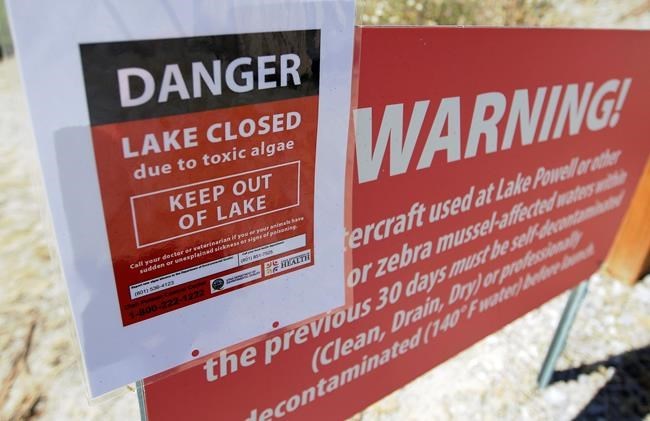
FILE - This July 20, 2016, file photo, a A danger lake closed sign is shown at Utah Lake, near American Fork, Utah. Scientists from the U.S. Geological Survey will study how nutrient levels contribute to algae bloom outbreaks on the heels of this summer's massive algae bloom that closed Utah Lake, sickened people and left farmers scrambling for clean water during some of the hottest days of the year. (AP Photo/Rick Bowmer, File)
August 13, 2016 - 8:58 AM
SALT LAKE CITY - Scientists spent this week studying how nutrient levels contribute to algae blooms on the heels of this summer's massive outbreak that closed Utah Lake, sickened people and left farmers scrambling for clean water during some of the hottest days of the year.
The goal of the study on the waters of Utah Lake and the Great Salt Lake is to determine how to predict outbreaks before they happen, said Christopher Shope, a research hydrologist with the U.S. Geological Survey in Utah.
That would allow state and county officials to be able to warn boaters, swimmers and farmers ahead of time, he said. The federal agency conducted the study.
Toxic algae is a problem around the U.S. An enormous outbreak in Florida this year fouled beaches on the Atlantic coast, and a 2014 outbreak at Lake Erie left more than 400,000 people in the Toledo, Ohio, area without tap water for two days.
This study is an experimental "proof of concept" project designed to show longer-term research is worth the financial investment, Shope said. Currently, state officials monitor water bodies for algae on a limited basis because equipment is expensive, and monitoring and analyzing are time-consuming.
U.S. Geological Survey teams used one set of equipment to collect data at each lake — in the Great Salt Lake's Gilbert Bay and throughout Utah Lake. A larger study of Utah Lake, for instance, would require five sets of monitoring equipment that cost $150,000 each and an additional $50,000 annually to operate.
The study aims to hone in on which nutrients are causing the algae. Researchers will look at wastewater treatment plants and agriculture operations, among other things, Shope said.
The study was launched after this summer's bloom that covered large parts of the 150-square-mile Utah Lake and left about 100 people with symptoms such as vomiting, headache and rashes.
The bacteria commonly known as blue-green algae spread rapidly, turning the water bright, antifreeze green with a pea soup texture and leaving scummy foam along the shore. The lake was reopened after the algae dissipated at most locations.
Ben Holcomb of Utah's Division of Water Quality said his team is grateful for the U.S. Geological Survey's assistance.
"It really helps us fill in those gaps across the lake," said Holcomb, the biological assessment program co-ordinator.
He said he's unaware of any way to get rid of the bloom in huge bodies of water with protected wildlife. But he said being able to closely monitor water readings in real time would give officials a tremendous tool.
"We would be able to get the word out quicker to perhaps keep people off the lake," Holcomb said. "The amount of data limits our ability to make good, quick decisions."
News from © The Associated Press, 2016